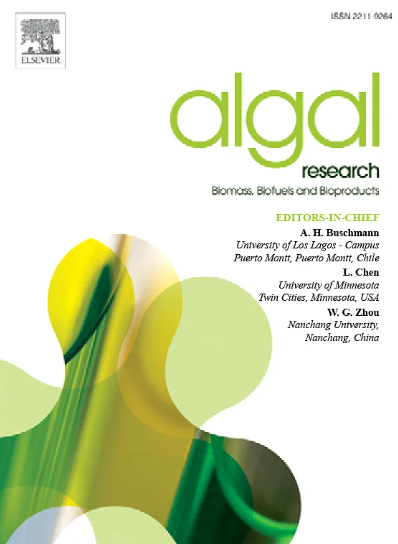微藻作为一种创新的可食用薄膜和食品涂料的活性成分
IF 4.6
2区 生物学
Q1 BIOTECHNOLOGY & APPLIED MICROBIOLOGY
Algal Research-Biomass Biofuels and Bioproducts
Pub Date : 2025-02-08
DOI:10.1016/j.algal.2025.103959
引用次数: 0
摘要
微藻是营养和生物活性化合物(多糖、蛋白质、脂类、维生素、矿物质、膳食纤维、生物活性肽、脂肪酸、维生素、酚类物质和类胡萝卜素)的来源,可能具有抗氧化和抗菌特性。微藻提取物和生物质有很大的潜力被纳入食品可食用薄膜和涂层的配方中。本文综述了近年来将微藻生物量及其提取物掺入可食用涂层和薄膜中以获得具有抗菌和抗氧化性能的材料的研究进展。并对其在食品保鲜中的应用进行了综述。螺旋藻属;普通小球藻提取物和生物质是薄膜配方中使用最多的,而铸造仍然是最常用的生产方法。此外,主要的生物聚合物有树胶、淀粉、酪蛋白酸钠、壳聚糖和分离蛋白。这些薄膜被应用于肉类、鱼类、海鲜、水果和蔬菜中,结果保持了所需的质地特性,减少了储存过程中的微生物数量,改善了技术和感官特性,并提高了生物活性化合物的浓度。有机会研究其他微藻种类、生产方法和生物聚合物类型。因此,我们得出结论,用微藻生产薄膜和涂层是一项新兴技术,具有不同的可能性,使其能够在食品工业中使用。本文章由计算机程序翻译,如有差异,请以英文原文为准。
Microalgae as an innovative active ingredient for edible films and coatings for food applications
Microalgae are a source of nutritional and bioactive compounds (polysaccharides, proteins, lipids, vitamins, minerals, dietary fiber, bioactive peptides, fatty acids, vitamins, phenolics, and carotenoids) that may present antioxidant and antimicrobial properties. Microalgae extracts and biomass have great potential to be incorporated into the formulation of edible films and coatings for foods. This review aimed to highlight recent research involving incorporating microalgae biomass and extracts into edible coatings and films to obtain materials with antimicrobial and antioxidant properties. Furthermore, their application in the preservation of foods is reviewed. Spirulina sp. and. Chlorella vulgaris extract and biomass are the most used in film formulation, and casting is still the most used production method. Furthermore, the main biopolymers are the gums, starch, sodium caseinate, chitosan, and protein isolates. The films were applied in meat, fish, seafood, fruits, and vegetables, resulting in maintenance of the desired texture properties, reduced microbial counts during storage, improved technological and sensory properties, and higher concentration of bioactive compounds. Opportunities are available to study other microalgae species, production methods, and types of biopolymers. Thus, it is concluded that producing films and coatings with microalgae is an emerging technology with different possibilities to enable its use in the food industry.
求助全文
通过发布文献求助,成功后即可免费获取论文全文。
去求助
来源期刊

Algal Research-Biomass Biofuels and Bioproducts
BIOTECHNOLOGY & APPLIED MICROBIOLOGY-
CiteScore
9.40
自引率
7.80%
发文量
332
期刊介绍:
Algal Research is an international phycology journal covering all areas of emerging technologies in algae biology, biomass production, cultivation, harvesting, extraction, bioproducts, biorefinery, engineering, and econometrics. Algae is defined to include cyanobacteria, microalgae, and protists and symbionts of interest in biotechnology. The journal publishes original research and reviews for the following scope: algal biology, including but not exclusive to: phylogeny, biodiversity, molecular traits, metabolic regulation, and genetic engineering, algal cultivation, e.g. phototrophic systems, heterotrophic systems, and mixotrophic systems, algal harvesting and extraction systems, biotechnology to convert algal biomass and components into biofuels and bioproducts, e.g., nutraceuticals, pharmaceuticals, animal feed, plastics, etc. algal products and their economic assessment
 求助内容:
求助内容: 应助结果提醒方式:
应助结果提醒方式:


